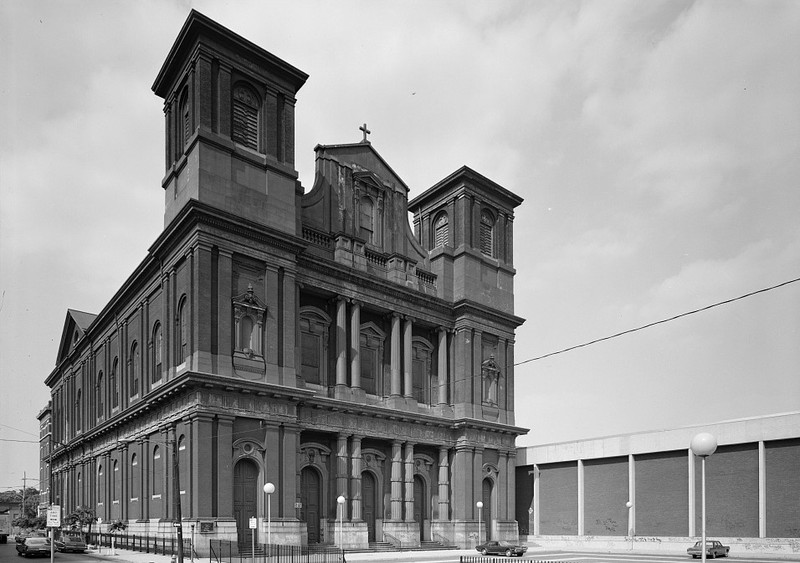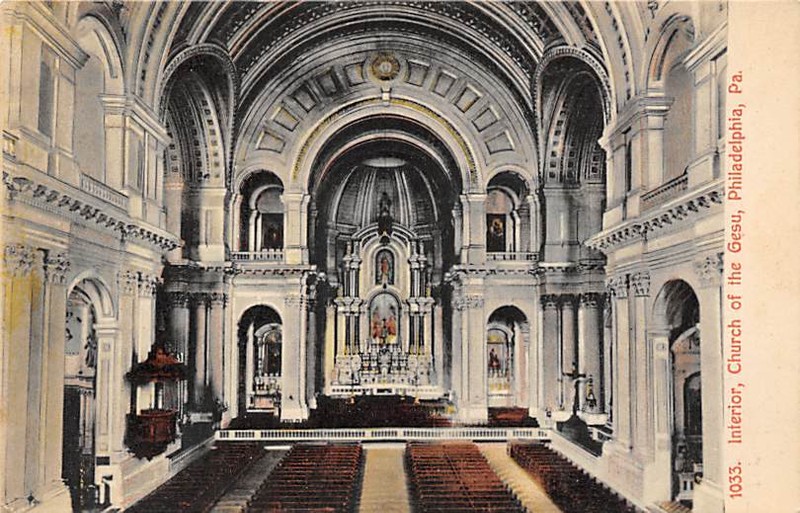Church of the Gesù
Introduction
Text-to-speech Audio
When the first Mass was celebrated inside of the church in 1888, the Gesù was not just a single building, but it was the focal point around which revolved entire communities – including multiple scholastic institutions, religious communities, and a neighborhood full of parishioners. Saint Joseph’s Preparatory School, Saint Joseph’s College (now University), and what is now called the Gesù School were largely dependent and united by the Gesù Church and parish. Although the parish closed in 1993, the church is still used by “the Prep” and the Gesù School. The Church of the Gesù was designed by Edwin F. Durang and modeled on the Church of the Gesù in Rome, the mother church of the Jesuit order.
Images
Side Elevation - Church of the Gesu, 1973

Postcard: Interior, Church of the Gesu, ca 1905

Backstory and Context
Text-to-speech Audio
When the first Mass was celebrated inside of the church in 1888, the Gesù was not just a single building, but it was the focal point around which revolved entire communities – including multiple scholastic institutions, religious communities, and a neighborhood full of parishioners. Saint Joseph’s Preparatory School, Saint Joseph’s College (now University), and what is now called the Gesù School were largely dependent and united by the Gesù Church and parish. Although the parish closed in 1993, the church is still used by “the Prep” and the Gesù School.
The Church of the Gesù here on Girard Ave. is a Jesuit church – a Roman Catholic Order that was founded by Saint Ignatius of Loyola (1491-1556) in 1540. Like many Jesuit churches around the world, it is modeled on the Church of the Gesù in Rome, the mother church of the Jesuit order (where St. Ignatius is buried today). Giovanni Bartolomeo di Lippi and Michelangelo were hired as architects for the Roman Gesù before “Jacopo Barozzi, known as Vignola, architect of the Farnesi, received the commission to build the church,” creating a Baroque style with “a single nave, side-chapels, and vaulted ceiling ….” The church in Rome thus provided the basic antecedent, style, and template for the church in Philadelphia, which was designed by Edwin F. Durang, a prolific local church architect.
The roots of St. Joseph’s Preparatory School and the Church of the Gesù go back to Old St Joseph’s Church in Old City Philadelphia. The first priest to establish a Catholic Church in Philadelphia was the Jesuit Joseph Greaton (1679-1753), who purchased a property between 3rd and 4th streets on May 15 1733. Some Philadelphians felt that Catholics should not be able to practice their religion, but this early conflict about religious liberty was decided in favor of Joseph Greaton, who was permitted to celebrate the only legal Catholic mass in the English-speaking world
St. Joseph’s College (now University) and the Prep, then part of the College, were founded in 1851 and originally met in buildings adjacent to Old St Joseph’s church. Felix Joseph Barbelin (1808-1869), a native of Luneville, France, a long-time beloved pastor of Old St. Joseph’s Church,[5] became the first president of the College and the Prep, and purchased the current property between Stiles, Thompson, 18th, and 17th streets in 1866.
Father Burchard Villiger, S.J. (1819-1902), a native of Switzerland who escaped religious persecution and came to the United States in 1848, took over the building of St. Joseph’s College in North Philadelphia.[9] In March 1868, Villiger was charged with building a “temporary” chapel on the site, which was supposed to be able to be converted into a piece of St. Joseph’s College at a later date. This church was opened on 6 December 1868, and was first called “New St. Joseph’s” and then “Holy Family.” In 1871, Villiger wrote, “Our first or temporary church in the College building, was opened for several months and the pews rented without having had any parish. A parish of small limits was afterward given us to attend, as an accidental work that might be given up to the Bishop at any time. But a college without a church we could never open anywhere … Our colleges must always have a church attached to them.”
Parishoners and the Jesuits broke ground for the Gesù on March 10, 1879 and the foundations were between twelve and fourteen feet thick. It is approx. 122 feet wide, 252 feet long, the side walls extend 84 feet, the center of the nave is 100 feet, the span of the nave is 76 feet.[14] The church was officially dedicated on 2 December 1888. Interestingly, the towers were never finished. In 1886, Villiger bought 5 bells in St. Louis, and they were installed in 1887. They are named after the Holy Name of Jesus, Mary, St. Joseph, St. Ignatius, St. Francis Xavier. Villiger intentionally left the church interior white, in the hopes that the interior would be made marble, but later Brother Francis C. Schroen, S.J., decorated the church. Currently, there are 15 altars in the church each with ornate decorations and artwork
Originally, the pews were rented; in 1910 there were 964 pew renters, who paid between 10 and 100 dollars a year - one estimate puts the working class and lower-middle class at 81 percent of the parish in 1911, with perhaps less than 40 parishioners of an actual professional class.
Sources
“Church of the Gesu” pamphlet accessed online at http://www.chiesadelgesu.org/documenti/presentazione_chiesa_del_gesu_roma.pdf
Contosta, David R. Saint Joseph’s: Philadelphia’s Jesuit University. Philadelphia: Saint Joseph’s University Press, 2000.
Golden Jubilee 1888-1934: Church of the Gesu. Privately published.
Gormley, James J. A History of St. Joseph’s Preparatory School 125 Years 1851-1976.
Ryan, John J., Memoir of the Life of Rev. Burchard Villiger of the Society of Jesus. Philadelphia: F. McManus, Jr. & Co., 1906.
Talbot, Francis X., Jesuit Education in Philadelphia: Saint Joseph’s College 1851-1926. Philadelphia: Saint Joseph’s College, 1927.
"Church of the Gesu (Roman Catholic), Eighteenth & Thompson Streets, Philadelphia, Philadelphia County, PA", Historic American Buildings Survey. https://www.loc.gov/pictures/collection/hh/item/pa1157
